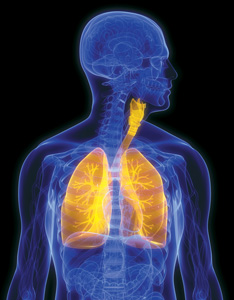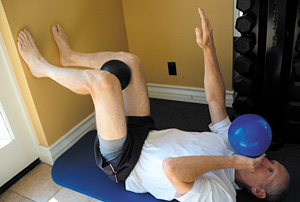In part two of this series [July 15 issue], I mentioned that the diaphragm or "Big D" is the most important muscle used in respiration while being intimately connected to the lumbar spine, gait and every neuromuscular function of the body.
Think about it: We come standard issue with a liver residing on the right side of our abdomen. In our thoracic cavity on the right side, we have three lobes of the lung. On the left side we have two lobes where the heart and aorta reside. The diaphragm has leaflets on the right and left sides composed of muscular "crura" and is prone to be more dome-shaped on the right, in part because of the liver below. In addition, the right side has stronger, deeper and lower crural attachments to the anterior lumbar bodies by one to one-and-a-half levels than the left. The leaflet of the left side is much smaller and as a result, the abdominal musculature on the left tends to be weaker.1
This asymmetry of lower lumbar attachment of the right leaflet is partially balanced on the left by a muscle behind the lower third of the sternum, back of the xiphoid and costal cartilage of ribs 2-6, reaching up one rib level higher on the left, known as the "transversus thoracis." Human beings, regardless of dominant hand, have an orientation of the thoraco-abdominal region to the right because the thicker and bigger crura of the right leaflet pulls our spine and torso in that direction. One of the ways we offset this orientation is with neuromuscular activation of the anterolateral abdominal wall during all phases of respiration.1-2
The Zone of Apposition
 According to physical therapist Ron Hruska, "The diaphragm's mechanical action and respiratory advantage depends on its relationship and anatomic arrangement with the rib cage."2 This begins to describe the functional domed shape of the diaphragm, called the "zone of apposition" or (ZOA). Imagine the thoracic cavity if viewed from the side, with a big "question mark" that portrays the diaphragm. The front end is attached inside the sternum and anterior ribs, arching up and back to create the top or dome of the question mark before angling back down to connect to the lumbar spine.2
According to physical therapist Ron Hruska, "The diaphragm's mechanical action and respiratory advantage depends on its relationship and anatomic arrangement with the rib cage."2 This begins to describe the functional domed shape of the diaphragm, called the "zone of apposition" or (ZOA). Imagine the thoracic cavity if viewed from the side, with a big "question mark" that portrays the diaphragm. The front end is attached inside the sternum and anterior ribs, arching up and back to create the top or dome of the question mark before angling back down to connect to the lumbar spine.2
This healthy dome-shaped diaphragm is needed not only for breathing, but also proper function of all the polyarticular muscle chains of the body. A balanced ZOA on both sides of the diaphragm provides optimum exhalation and inspiration on left and right sides of the thorax with nearly equal contraction and expansion of the rib cage. This occurs with coordinated activation of the diaphragm and the anterolateral abdominal wall, working in a balanced and harmonious manner.
If there is weakness or decreased activity of the abdominal muscles, respiration and stabilization will be compromised.1 And as McGill has eloquently stated, if there is a choice between respiration and stabilization, the NMS will always prioritize breathing.
Dysfunction occurs over time when either side of the diaphragm loses its ZOA and stays more flat or contracted, allowing the lower anterior rib cage to "flare." This causes more convexity of the left lateral chest wall and rib cage, and in part closes down the right side of the chest wall, inhibiting full inhalation on the right as a result of partial exhalation on the left side.
Excess Diaphragmatic Tone
In chiropractic, we often talk about the issue of "tone." A dysfunctional, flat diaphragm, especially on the left side, is a good example of too much tone or chronic contraction. This excess in tone inhibits full exhalation on the left because the diaphragm is not relaxing into a domed shape and not fully deflating the lungs.
In addition, the anterolateral abdominal wall lacks the ability to hold the anterior ribs in a more functional inferior position, thereby maintaining the ZOA of the diaphragm. The absence of abdominal wall function allows rib "flaring" with excessive external rotation of the rib cage on the left side and internal rotation on the right. Airflow in general moves more easily into the left chest wall because of the rotational influence of the ribs caused by anatomical asymmetries that become more pronounced over time.2
Remember Janda's "lower crossed syndrome"? This rib flaring, combined with lumbar hyperlordosis, is in large part a consequence of weak abdominal muscles, especially on the left side. Add too much tone in the diaphragm on the left with too much tightness or tone of the lumbar extensors, and you then have a potential garden of chronic dysfunction and pain. Say hello to headaches and neck pain if this dysfunction persists, particularly when muscles like the SCM and scalenes are used inappropriately to raise the thorax and shoulders just to get enough air into the lungs. If you have athletes you treat, rehab or train, this combination of dysfunction will bleed power and performance while leaving them more susceptible to injury!
Are you starting to get a picture of what occurs with excessive asymmetry? Sure, the diaphragm is used for breathing, but with one side being more muscular and bigger, it now begins to provide an excessive force to one side of the spine, affecting the entire torso and gait – and communicating dysfunction through all of the polyarticular chains.
Just because it is bigger and more muscular on the right side doesn't mean it is working at its full potential. It can't until the left side of the diaphragm and abdominal wall is activated starting with full exhalation, restoring a balanced and functional breathing pattern to both sides through retraining the diaphragm and abdominal muscles.1,3
The point is that we need to restore a balanced zone of apposition (ZOA) on both sides of the diaphragm, especially on the left, which tends to get lazy with shallow exhalation and has inadequate abdominal activation during all phases of respiration. To do this, we need to activate the abdominal wall starting with full exhalation, thereby maintaining position of the rib cage that is not flared while breathing in (especially on the left side). We also need to expand the lungs and chest wall on the right side while providing for more internal rotation of the ribs on the left side and more external rotation on the right side. The goal? Provide a more balanced skeletal orientation – and do it with one exercise!
Balloon Blowing
This is where the value of blowing up a balloon comes in handy, as described by Boyle, Olinick and Lewis. One of the best therapeutic exercises can be described as a 90/90 bridge with a ball and balloon. The following is a list of instructions developed by the Postural Restoration Institute:3
- Lie on your back with your feet flat on a wall, and knees and hips bent at a 90/90-degree angle.
- Place a 4-6-inch ball between your knees.
- Place your right arm above your head while holding a balloon in your left hand.
- Inhale through your nose and as you exhale through your mouth, perform a pelvic tilt so your tailbone is raised slightly off the mat. Keep the lower back flat on the mat. Do not press your feet into the wall; instead, pull down with your heels.
- You should feel the back of your thighs and inner thighs engage, keeping pressure on the ball. Maintain this position for the remainder of the exercise.
- Inhale through your nose and slowly blow out into the balloon.
- Pause for 3 seconds with your tongue positioned on the roof of your mouth to prevent airflow out of the balloon.
- Without pinching the neck of the balloon and while keeping your tongue on the roof of your mouth, inhale again through your nose.
- Slowly blow out as you stabilize the balloon with your left hand.
- Do not strain your neck or cheeks as you blow.
- After the fourth breath in, pinch the balloon neck and remove it from your mouth. Let the air out of the balloon.
- Relax; then repeat the sequence four more times.
 One of the best therapeutic exercises for dysfunctional breathing can be described as a 90/90 bridge with a ball and a balloon.
This is one of many effective exercises that can be utilized to restore the ZOA and functional breathing patterns. Since breathing patterns are closely linked to musculoskeletal pain and spinal alignment problems, chiropractic adjustments are a natural for this combination treatment modality, along with soft-tissue work on trigger points associated with breathing dysfunction. Breathing dysfunction is a significant cause of the vertebral subluxation complex and needs to be assessed for chiropractic treatment to be even more effective and complete.
One of the best therapeutic exercises for dysfunctional breathing can be described as a 90/90 bridge with a ball and a balloon.
This is one of many effective exercises that can be utilized to restore the ZOA and functional breathing patterns. Since breathing patterns are closely linked to musculoskeletal pain and spinal alignment problems, chiropractic adjustments are a natural for this combination treatment modality, along with soft-tissue work on trigger points associated with breathing dysfunction. Breathing dysfunction is a significant cause of the vertebral subluxation complex and needs to be assessed for chiropractic treatment to be even more effective and complete.
If during any of part of this exercise, your patient experiences pain, lightheadedness or any other symptom you determine to be suspicious, discontinue its use. As always, use your best clinical judgment when applying any corrective strategy. It is highly recommended you receive appropriate training before implementing this corrective strategy in practice.
References
- "Postural Respiration: An Integrated Approach to Treatment of Patterned Thoraco-Abdominal Pathomechanics." Postural Restoration Institute (course notebook).
- Hruska R. "ZOA Position and Mechanical Function." Available on the Postural Restoration Institute Web site.
- Boyle KL, Olinick J, Lewis C. "Clinical Suggestion: The Value of Blowing Up a Balloon." N Amer J Sport Phys Ther, September 2010;5(3):179-88.
Part 1 of this article appeared in the June 17, 2012 issue; part 2 ran in the July 15 issue.
Dr. Robert "Skip" George practices in La Jolla, Calif., where he integrates chiropractic, rehabilitation and sports performance training. He is a certified Functional Movement Screen instructor and has lectured nationally on subjects related to the chiropractic profession. He can be contacted with questions and comments at
.




